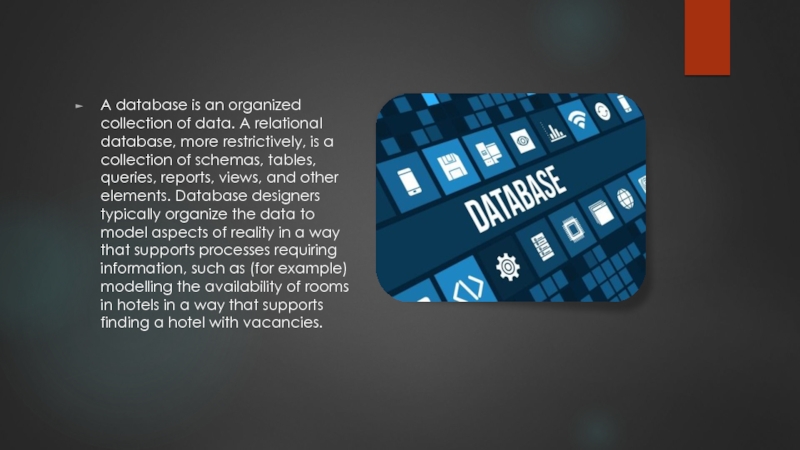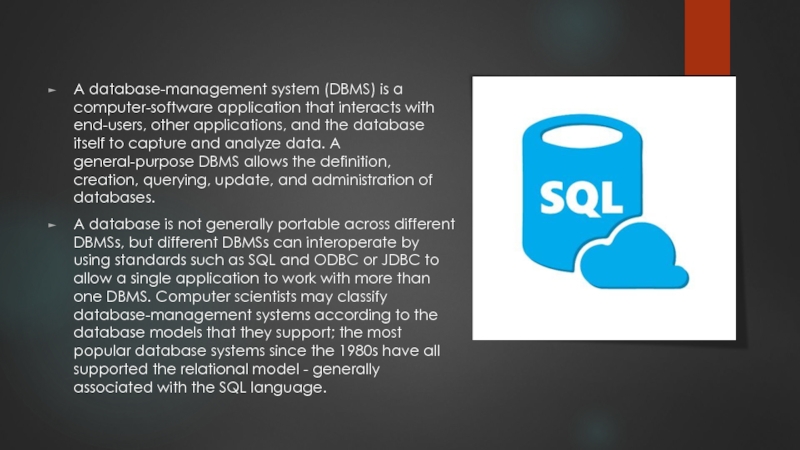- Главная
- Разное
- Дизайн
- Бизнес и предпринимательство
- Аналитика
- Образование
- Развлечения
- Красота и здоровье
- Финансы
- Государство
- Путешествия
- Спорт
- Недвижимость
- Армия
- Графика
- Культурология
- Еда и кулинария
- Лингвистика
- Английский язык
- Астрономия
- Алгебра
- Биология
- География
- Детские презентации
- Информатика
- История
- Литература
- Маркетинг
- Математика
- Медицина
- Менеджмент
- Музыка
- МХК
- Немецкий язык
- ОБЖ
- Обществознание
- Окружающий мир
- Педагогика
- Русский язык
- Технология
- Физика
- Философия
- Химия
- Шаблоны, картинки для презентаций
- Экология
- Экономика
- Юриспруденция
Database презентация
Содержание
- 1. Database
- 2. A database is an organized collection of
- 3. A database-management system (DBMS) is a computer-software
- 4. Terminology and overview. Formally, a "database" refers
- 5. Existing DBMSs provide various functions that allow
- 6. Both a database and its DBMS conform
- 7. Since DBMSs comprise a significant market, computer
- 8. Thank you for attention
Слайд 2A database is an organized collection of data. A relational database,
Слайд 3A database-management system (DBMS) is a computer-software application that interacts with
A database is not generally portable across different DBMSs, but different DBMSs can interoperate by using standards such as SQL and ODBC or JDBC to allow a single application to work with more than one DBMS. Computer scientists may classify database-management systems according to the database models that they support; the most popular database systems since the 1980s have all supported the relational model - generally associated with the SQL language.
Слайд 4Terminology and overview.
Formally, a "database" refers to a set of related
Слайд 5Existing DBMSs provide various functions that allow management of a database
Data definition – Creation, modification and removal of definitions that define the organization of the data.
Update – Insertion, modification, and deletion of the actual data.
Retrieval – Providing information in a form directly usable or for further processing by other applications. The retrieved data may be made available in a form basically the same as it is stored in the database or in a new form obtained by altering or combining existing data from the database.
Administration – Registering and monitoring users, enforcing data security, monitoring performance, maintaining data integrity, dealing with concurrency control, and recovering information that has been corrupted by some event such as an unexpected system failure.
Слайд 6Both a database and its DBMS conform to the principles of
Physically, database servers are dedicated computers that hold the actual databases and run only the DBMS and related software. Database servers are usually multiprocessor computers, with generous memory and RAID disk arrays used for stable storage. RAID is used for recovery of data if any of the disks fail. Hardware database accelerators, connected to one or more servers via a high-speed channel, are also used in large volume transaction processing environments. DBMSs are found at the heart of most database applications. DBMSs may be built around a custom multitasking kernel with built-in networking support, but modern DBMSs typically rely on a standard operating system to provide these functions.
Слайд 7Since DBMSs comprise a significant market, computer and storage vendors often
Databases and DBMSs can be categorized according to the database model(s) that they support (such as relational or XML), the type(s) of computer they run on (from a server cluster to a mobile phone), the query language(s) used to access the database (such as SQL or XQuery), and their internal engineering, which affects performance, scalability, resilience, and security.













